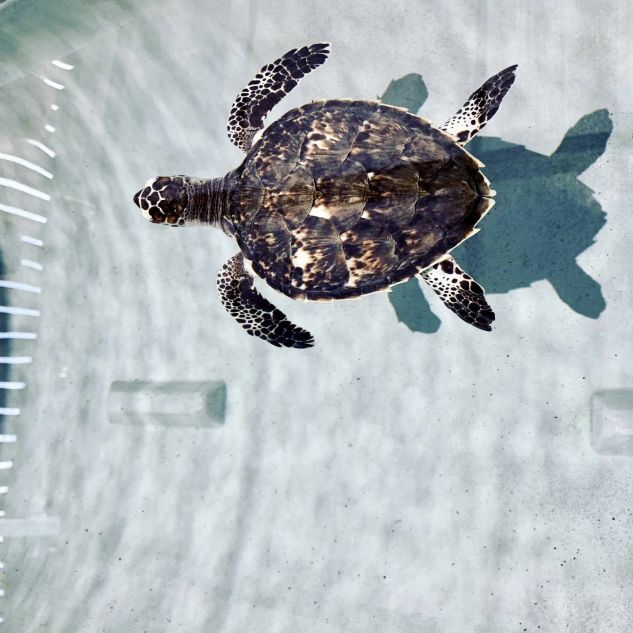
Written By
Mykala Wright
College
College of Public Health, Medical and Veterinary Sciences
Publish Date
15 June 2021
Related Study Areas
Turtles in trouble
Eleven critically endangered sea turtles are making waves in the Great Barrier Reef after more than two years at James Cook University’s Turtle Health Research Facility. The facility, affectionately referred to as The Caraplace – named after the top of a turtle’s shell – released the hawksbill turtles early last month after conducting a number of world-first studies with the animals.
Professor Ellen Ariel, Director of the facility, worked with the turtles from when they were hatchlings.
“The turtles we have at the facility are study animals, so we look at all the normal behaviours and parameters of their health. They contribute greatly to science,” Ellen says.
Sea turtles have been around for over 100 million years, but now, their survival is at risk. Six of the planet’s seven remaining species are listed as threatened or endangered, and in Australian waters hawksbills are at the top of that list. Although many natural dangers contribute to their plummeting populations, it is human activities such as wildlife trade and coastal development that are tipping the scales against their survival.


Release of the hawksbills
One bright spot is the nesting populations of hawksbills that can be found near the Great Barrier Reef. These gave JCU PhD student Rebecca Diggins the opportunity to research this rare species.
“Having the chance to have the hawksbills in our research facility was really one of a kind,” Rebecca says. “We have had a really unique insight into the development of these turtles which could be critical in preserving them for future generations.”
After turtle hatchlings emerge from their nests and make the journey across the beach to reach the shore, they typically disappear into the ocean and are not seen for several years. This period is referred to as the “lost years” because not much is known about the young reptiles or what they do during this time. The Caraplace is the first facility of its kind purposely built for monitoring and studying turtles during this stage.
“The hawksbills grew to be between 5 and 8 kilos, a size where you would normally see them on a reef, and so it was time to release them into the Great Barrier Reef,” Rebecca says.
“It was a surreal experience. We’re used to seeing them in their tanks, and it was really wonderful being able to see them in their natural environment. To see how easily they can glide against the currents, and watch them have funny interactions with clownfish – one got a bit too close to an anemone!”
What does a healthy turtle look like?
The Turtle Health Research Facility was established by Ellen in response to the fallout of cyclone Yasi. In 2011, Yasi tore across the North Queensland coast leaving a trail of sick, dying, and dead sea turtles washing up in its wake.
“The seagrass beds were smashed, and the turtles didn’t have anything to eat for a long time, so they were starving and becoming sick,” Ellen says. “The rehabilitation centres were overflowing, so we stepped up to help out with that here at JCU.”
Using her background in reptile virology, along with a number of donations, Ellen turned what was once a piggery into a temporary emergency recovery centre for the stranded turtles. Upon rehabilitation of the animals, she discovered that although they were all treated the same, only some of the turtles survived.
“The problem was, we didn’t know how to diagnose what was wrong with them,” she says.
“Before you can start diagnosing and treating a sick turtle, you need to know what a healthy turtle looks like. So, to learn what a healthy turtle looks like, we created the centre, and that’s what we’re studying here.”
Academics and students from Australia and around the world are producing ground-breaking research findings thanks to the facility. The types of studies taking place vary. Some of them consider the natural behaviours of turtles, like whether they present as shy or bold and if they have a preference for certain colours, while other studies look at their immune system development or how their bodies metabolise food.
“The study on the metabolism of the hawksbill turtles helps us know when we should be feeding them before release to give them optimal chances,” Rebecca says. “So it’s also applicable to rehab centres. When a turtle is brought in sick or injured and it’s rehabilitated, typically facilities will give it a big final feed before releasing it. But can you imagine having a big dinner and then going for a run?
“We really take every opportunity to learn as much as we can, across multiple disciplines, so that we can facilitate the diagnosis and treatment of sick turtles to maximise their chances of survival on release.”
How to help
While spending time with baby turtles might sound like fun, meeting the needs of the reptiles takes a large investment of both money and time. The Caraplace functions predominantly on the generosity of volunteers and donors.
“Running the facility is a huge team effort, even before any of the research takes place. We have an amazing team of trained volunteers that come in to feed and clean up after the turtles,” Rebecca says.
“We do a lot of fundraising to help pay for the turtles’ food and saltwater, which is very expensive. It’s a lot of time, effort, and money, but we are learning a lot. We are filling the empty pages in the book on turtle health.”
Ready to make a difference? Support a turtle by making a donation to The Caraplace. Or want to know more about the exciting work happening at the facility? Keep up to date with The Caraplace and its innovative research.